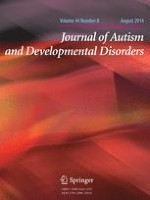01-08-2014 | Original Paper
A Twin Study of Heritable and Shared Environmental Contributions to Autism
Gepubliceerd in: Journal of Autism and Developmental Disorders | Uitgave 8/2014
Log in om toegang te krijgenAbstract
The present study examined genetic and shared environment contributions to quantitatively-measured autism symptoms and categorically-defined autism spectrum disorders (ASD). Participants included 568 twins from the Interactive Autism Network. Autism symptoms were obtained using the Social Communication Questionnaire and Social Responsiveness Scale. Categorically-defined ASD was based on clinical diagnoses. DeFries-Fulker and liability threshold models examined etiologic influences. Very high heritability was observed for extreme autism symptom levels (\( {\text{h}}_{g}^{2} = . 9 2{-} 1. 20 \)). Extreme levels of social and repetitive behavior symptoms were strongly influenced by common genetic factors. Heritability of categorically-defined ASD diagnosis was comparatively low (.21, 95 % CI 0.15–0.28). High heritability of extreme autism symptom levels confirms previous observations of strong genetic influences on autism. Future studies will require large, carefully ascertained family pedigrees and quantitative symptom measurements.
